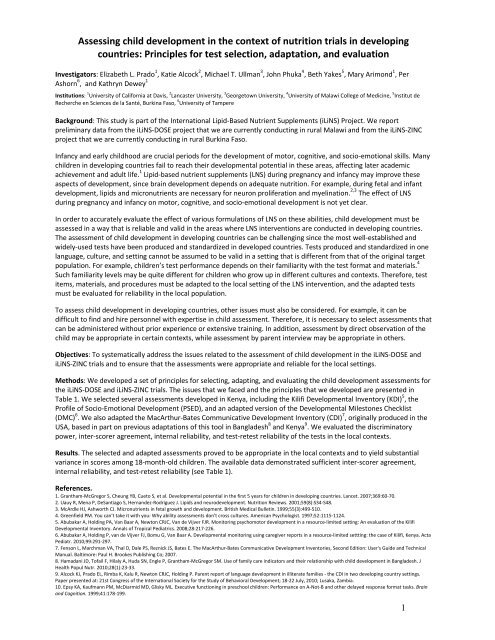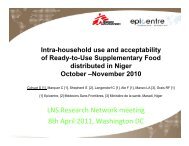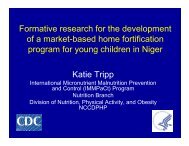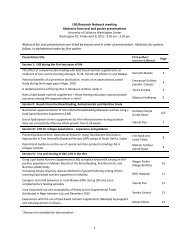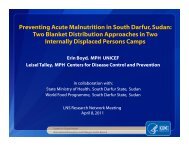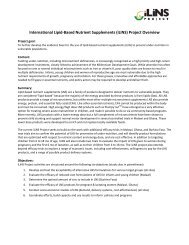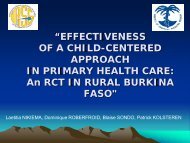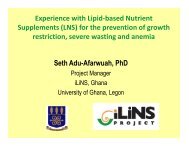Assessing child development in the context of ... - The iLiNS Project
Assessing child development in the context of ... - The iLiNS Project
Assessing child development in the context of ... - The iLiNS Project
Create successful ePaper yourself
Turn your PDF publications into a flip-book with our unique Google optimized e-Paper software.
<strong>Assess<strong>in</strong>g</strong> <strong>child</strong> <strong>development</strong> <strong>in</strong> <strong>the</strong> <strong>context</strong> <strong>of</strong> nutrition trials <strong>in</strong> develop<strong>in</strong>g<br />
countries: Pr<strong>in</strong>ciples for test selection, adaptation, and evaluation<br />
Investigators: Elizabeth L. Prado 1 , Katie Alcock 2 , Michael T. Ullman 3 , John Phuka 4 , Beth Yakes 5 , Mary Arimond 1 , Per<br />
Ashorn 6 , and Kathryn Dewey 1<br />
Institutions: 1 University <strong>of</strong> California at Davis, 2 Lancaster University, 3 Georgetown University, 4 University <strong>of</strong> Malawi College <strong>of</strong> Medic<strong>in</strong>e, 5 Institut de<br />
Recherche en Sciences de la Santé, Burk<strong>in</strong>a Faso, 6 University <strong>of</strong> Tampere<br />
Background: This study is part <strong>of</strong> <strong>the</strong> International Lipid‐Based Nutrient Supplements (<strong>iLiNS</strong>) <strong>Project</strong>. We report<br />
prelim<strong>in</strong>ary data from <strong>the</strong> <strong>iLiNS</strong>‐DOSE project that we are currently conduct<strong>in</strong>g <strong>in</strong> rural Malawi and from <strong>the</strong> <strong>iLiNS</strong>‐ZINC<br />
project that we are currently conduct<strong>in</strong>g <strong>in</strong> rural Burk<strong>in</strong>a Faso.<br />
Infancy and early <strong>child</strong>hood are crucial periods for <strong>the</strong> <strong>development</strong> <strong>of</strong> motor, cognitive, and socio‐emotional skills. Many<br />
<strong>child</strong>ren <strong>in</strong> develop<strong>in</strong>g countries fail to reach <strong>the</strong>ir <strong>development</strong>al potential <strong>in</strong> <strong>the</strong>se areas, affect<strong>in</strong>g later academic<br />
achievement and adult life. 1 Lipid‐based nutrient supplements (LNS) dur<strong>in</strong>g pregnancy and <strong>in</strong>fancy may improve <strong>the</strong>se<br />
aspects <strong>of</strong> <strong>development</strong>, s<strong>in</strong>ce bra<strong>in</strong> <strong>development</strong> depends on adequate nutrition. For example, dur<strong>in</strong>g fetal and <strong>in</strong>fant<br />
<strong>development</strong>, lipids and micronutrients are necessary for neuron proliferation and myel<strong>in</strong>ation. 2,3 <strong>The</strong> effect <strong>of</strong> LNS<br />
dur<strong>in</strong>g pregnancy and <strong>in</strong>fancy on motor, cognitive, and socio‐emotional <strong>development</strong> is not yet clear.<br />
In order to accurately evaluate <strong>the</strong> effect <strong>of</strong> various formulations <strong>of</strong> LNS on <strong>the</strong>se abilities, <strong>child</strong> <strong>development</strong> must be<br />
assessed <strong>in</strong> a way that is reliable and valid <strong>in</strong> <strong>the</strong> areas where LNS <strong>in</strong>terventions are conducted <strong>in</strong> develop<strong>in</strong>g countries.<br />
<strong>The</strong> assessment <strong>of</strong> <strong>child</strong> <strong>development</strong> <strong>in</strong> develop<strong>in</strong>g countries can be challeng<strong>in</strong>g s<strong>in</strong>ce <strong>the</strong> most well‐established and<br />
widely‐used tests have been produced and standardized <strong>in</strong> developed countries. Tests produced and standardized <strong>in</strong> one<br />
language, culture, and sett<strong>in</strong>g cannot be assumed to be valid <strong>in</strong> a sett<strong>in</strong>g that is different from that <strong>of</strong> <strong>the</strong> orig<strong>in</strong>al target<br />
population. For example, <strong>child</strong>ren’s test performance depends on <strong>the</strong>ir familiarity with <strong>the</strong> test format and materials. 4<br />
Such familiarity levels may be quite different for <strong>child</strong>ren who grow up <strong>in</strong> different cultures and <strong>context</strong>s. <strong>The</strong>refore, test<br />
items, materials, and procedures must be adapted to <strong>the</strong> local sett<strong>in</strong>g <strong>of</strong> <strong>the</strong> LNS <strong>in</strong>tervention, and <strong>the</strong> adapted tests<br />
must be evaluated for reliability <strong>in</strong> <strong>the</strong> local population.<br />
To assess <strong>child</strong> <strong>development</strong> <strong>in</strong> develop<strong>in</strong>g countries, o<strong>the</strong>r issues must also be considered. For example, it can be<br />
difficult to f<strong>in</strong>d and hire personnel with expertise <strong>in</strong> <strong>child</strong> assessment. <strong>The</strong>refore, it is necessary to select assessments that<br />
can be adm<strong>in</strong>istered without prior experience or extensive tra<strong>in</strong><strong>in</strong>g. In addition, assessment by direct observation <strong>of</strong> <strong>the</strong><br />
<strong>child</strong> may be appropriate <strong>in</strong> certa<strong>in</strong> <strong>context</strong>s, while assessment by parent <strong>in</strong>terview may be appropriate <strong>in</strong> o<strong>the</strong>rs.<br />
Objectives: To systematically address <strong>the</strong> issues related to <strong>the</strong> assessment <strong>of</strong> <strong>child</strong> <strong>development</strong> <strong>in</strong> <strong>the</strong> <strong>iLiNS</strong>‐DOSE and<br />
<strong>iLiNS</strong>‐ZINC trials and to ensure that <strong>the</strong> assessments were appropriate and reliable for <strong>the</strong> local sett<strong>in</strong>gs.<br />
Methods: We developed a set <strong>of</strong> pr<strong>in</strong>ciples for select<strong>in</strong>g, adapt<strong>in</strong>g, and evaluat<strong>in</strong>g <strong>the</strong> <strong>child</strong> <strong>development</strong> assessments for<br />
<strong>the</strong> <strong>iLiNS</strong>‐DOSE and <strong>iLiNS</strong>‐ZINC trials. <strong>The</strong> issues that we faced and <strong>the</strong> pr<strong>in</strong>ciples that we developed are presented <strong>in</strong><br />
Table 1. We selected several assessments developed <strong>in</strong> Kenya, <strong>in</strong>clud<strong>in</strong>g <strong>the</strong> Kilifi Developmental Inventory (KDI) 5 , <strong>the</strong><br />
Pr<strong>of</strong>ile <strong>of</strong> Socio‐Emotional Development (PSED), and an adapted version <strong>of</strong> <strong>the</strong> Developmental Milestones Checklist<br />
(DMC) 6 . We also adapted <strong>the</strong> MacArthur‐Bates Communicative Development Inventory (CDI) 7 , orig<strong>in</strong>ally produced <strong>in</strong> <strong>the</strong><br />
USA, based <strong>in</strong> part on previous adaptations <strong>of</strong> this tool <strong>in</strong> Bangladesh 8 and Kenya 9 . We evaluated <strong>the</strong> discrim<strong>in</strong>atory<br />
power, <strong>in</strong>ter‐scorer agreement, <strong>in</strong>ternal reliability, and test‐retest reliability <strong>of</strong> <strong>the</strong> tests <strong>in</strong> <strong>the</strong> local <strong>context</strong>s.<br />
Results. <strong>The</strong> selected and adapted assessments proved to be appropriate <strong>in</strong> <strong>the</strong> local <strong>context</strong>s and to yield substantial<br />
variance <strong>in</strong> scores among 18‐month‐old <strong>child</strong>ren. <strong>The</strong> available data demonstrated sufficient <strong>in</strong>ter‐scorer agreement,<br />
<strong>in</strong>ternal reliability, and test‐retest reliability (see Table 1).<br />
References.<br />
1. Grantham‐McGregor S, Cheung YB, Cueto S, et al. Developmental potential <strong>in</strong> <strong>the</strong> first 5 years for <strong>child</strong>ren <strong>in</strong> develop<strong>in</strong>g countries. Lancet. 2007;369:60‐70.<br />
2. Uauy R, Mena P, DeSantiago S, Hernandez‐Rodriguez J. Lipids and neuro<strong>development</strong>. Nutrition Reviews. 2001;59(8):S34‐S48.<br />
3. McArdle HJ, Ashworth CJ. Micronutrients <strong>in</strong> fetal growth and <strong>development</strong>. British Medical Bullet<strong>in</strong>. 1999;55(3):499‐510.<br />
4. Greenfield PM. You can't take it with you: Why ability assessments don't cross cultures. American Psychologist. 1997;52:1115‐1124.<br />
5. Abubakar A, Hold<strong>in</strong>g PA, Van Baar A, Newton CRJC, Van de Vijver FJR. Monitor<strong>in</strong>g psychomotor <strong>development</strong> <strong>in</strong> a resource‐limited sett<strong>in</strong>g: An evaluation <strong>of</strong> <strong>the</strong> Kilifi<br />
Developmental Inventory. Annals <strong>of</strong> Tropical Pediatrics. 2008;28:217‐226.<br />
6. Abubakar A, Hold<strong>in</strong>g P, van de Vijver FJ, Bomu G, Van Baar A. Developmental monitor<strong>in</strong>g us<strong>in</strong>g caregiver reports <strong>in</strong> a resource‐limited settt<strong>in</strong>g: <strong>the</strong> case <strong>of</strong> Kilifi, Kenya. Acta<br />
Pediatr. 2010;99:291‐297.<br />
7. Fenson L, Marchman VA, Thal D, Dale PS, Reznick JS, Bates E. <strong>The</strong> MacArthur‐Bates Communicative Development Inventories, Second Edition: User's Guide and Technical<br />
Manual. Baltimore: Paul H. Brookes Publish<strong>in</strong>g Co; 2007.<br />
8. Hamadani JD, T<strong>of</strong>ail F, Hilaly A, Huda SN, Engle P, Grantham‐McGregor SM. Use <strong>of</strong> family care <strong>in</strong>dicators and <strong>the</strong>ir relationship with <strong>child</strong> <strong>development</strong> <strong>in</strong> Bangladesh. J<br />
Health Popul Nutr. 2010;28(1):23‐33.<br />
9. Alcock KJ, Prado EL, Rimba K, Kalu R, Newton CRJC, Hold<strong>in</strong>g P. Parent report <strong>of</strong> language <strong>development</strong> <strong>in</strong> illiterate families ‐ <strong>the</strong> CDI <strong>in</strong> two develop<strong>in</strong>g country sett<strong>in</strong>gs.<br />
Paper presented at: 21st Congress <strong>of</strong> <strong>the</strong> International Society for <strong>the</strong> Study <strong>of</strong> Behavioral Development; 18‐22 July, 2010; Lusaka, Zambia.<br />
10. Epsy KA, Kaufmann PM, McDiarmid MD, Glisky ML. Executive function<strong>in</strong>g <strong>in</strong> preschool <strong>child</strong>ren: Performance on A‐Not‐B and o<strong>the</strong>r delayed response format tasks. Bra<strong>in</strong><br />
and Cognition. 1999;41:178‐199.<br />
1
Table 1. <strong>The</strong> issues that we considered and <strong>the</strong> pr<strong>in</strong>ciples that we developed for <strong>the</strong> assessment <strong>of</strong> <strong>child</strong> <strong>development</strong><br />
<strong>in</strong> <strong>the</strong> <strong>iLiNS</strong>‐DOSE and <strong>iLiNS</strong>‐ZINC trials.<br />
Issue Pr<strong>in</strong>ciple <strong>iLiNS</strong>‐DOSE, Malawi <strong>iLiNS</strong>‐ZINC, Burk<strong>in</strong>a Faso<br />
Many different abilities<br />
develop dur<strong>in</strong>g <strong>in</strong>fancy<br />
and early <strong>child</strong>hood and<br />
are likely to be<br />
<strong>in</strong>fluenced by nutrition.<br />
Few or no<br />
<strong>development</strong>al tests<br />
have been produced <strong>in</strong><br />
<strong>the</strong> local sett<strong>in</strong>g.<br />
<strong>The</strong> data collectors may<br />
not have a very high<br />
level <strong>of</strong> education or<br />
previous experience<br />
with <strong>development</strong>al<br />
assessment.<br />
In order to detect any<br />
effect <strong>of</strong> LNS, test<br />
scores should be able to<br />
differentiate between<br />
<strong>child</strong>ren <strong>of</strong> <strong>the</strong> same<br />
age (18 months) with<br />
different abilities.<br />
<strong>The</strong> location may be<br />
crowded and noisy<br />
<strong>the</strong>refore not conducive<br />
to direct assessment <strong>of</strong><br />
<strong>the</strong> <strong>child</strong>. It may be<br />
difficult to get a clear<br />
picture <strong>of</strong> certa<strong>in</strong> skills<br />
when spend<strong>in</strong>g a limited<br />
amount <strong>of</strong> time with <strong>the</strong><br />
<strong>child</strong>.<br />
Limited time and<br />
resources.<br />
Select tests that assess a<br />
wide range <strong>of</strong> abilities<br />
that may be <strong>in</strong>fluenced<br />
by LNS.<br />
Select tests that have<br />
been produced <strong>in</strong> a<br />
similar sett<strong>in</strong>g or adapt<br />
tests that have been<br />
produced <strong>in</strong> a dissimilar<br />
sett<strong>in</strong>g. In both cases,<br />
evaluate <strong>the</strong> tests for<br />
reliability <strong>in</strong> <strong>the</strong> local<br />
<strong>context</strong>.<br />
<strong>The</strong> testers should be<br />
able to be tra<strong>in</strong>ed <strong>in</strong> 2‐3<br />
weeks without prior<br />
experience. Scor<strong>in</strong>g<br />
should be relatively clear<br />
and straightforward,<br />
which can be evaluated<br />
by <strong>in</strong>ter‐scorer<br />
agreement.<br />
Test scores should show<br />
a substantial amount <strong>of</strong><br />
variance <strong>in</strong> <strong>child</strong>ren at<br />
<strong>the</strong> target age (18<br />
months).<br />
When direct assessment<br />
is problematic, evaluate<br />
<strong>the</strong> <strong>child</strong> based on<br />
parent <strong>in</strong>terview.<br />
<strong>The</strong> assessments should<br />
be relatively brief to<br />
adm<strong>in</strong>ister.<br />
<strong>The</strong> KDI assesses f<strong>in</strong>e and gross motor<br />
<strong>development</strong>. <strong>The</strong> PSED assesses socioemotional<br />
<strong>development</strong>. <strong>The</strong> MacArthur‐<br />
Bates CDI assesses language <strong>development</strong>.<br />
<strong>The</strong> A not B task assesses work<strong>in</strong>g memory<br />
and executive function. 10<br />
<strong>The</strong> KDI and PSED were produced <strong>in</strong> Kenya, <strong>in</strong><br />
a sett<strong>in</strong>g similar to <strong>the</strong> <strong>iLiNS</strong>‐DOSE study area.<br />
<strong>The</strong> A not B task was previously adapted for<br />
Kenya. <strong>The</strong> MacArthur‐Bates CDI has been<br />
successfully adapted to similar sett<strong>in</strong>gs (Kenya<br />
and Bangladesh). Data from <strong>the</strong> first 71 <strong>iLiNS</strong>‐<br />
DOSE <strong>child</strong>ren evaluated at age 18 months:<br />
Internal Test‐retest<br />
reliability reliability<br />
Cronbach’s Alpha r<br />
KDI: .67 .57<br />
PSED: .69 .66<br />
CDI: .98 .94<br />
A not B: Not yet available<br />
For each test, <strong>the</strong> testers were tra<strong>in</strong>ed <strong>in</strong> 2‐3<br />
weeks. Inter‐scorer agreement was evaluated<br />
at <strong>the</strong> completion <strong>of</strong> tra<strong>in</strong><strong>in</strong>g.<br />
Inter‐scorer agreement (n = 18):<br />
KDI: 95%<br />
PSED: 89%<br />
CDI: 96%<br />
A not B: 98%<br />
Data from <strong>the</strong> first 71 <strong>iLiNS</strong>‐DOSE <strong>child</strong>ren<br />
evaluated at age 18 months:<br />
KDI: n = 45, range = 35‐47, mean=41, SD=3<br />
PSED: n = 71, range = 4‐34, mean=16, SD=6<br />
CDI: n = 65, range = 0‐90, mean=34, SD=25<br />
A not B: n = 54, range = 0‐10, mean=6, SD=2<br />
It is difficult to obta<strong>in</strong> a complete picture <strong>of</strong> a<br />
<strong>child</strong>’s language ability and socio‐emotional<br />
ability <strong>in</strong> a short (~ 1 hour) test session.<br />
However, parents spend substantial amounts<br />
<strong>of</strong> time with <strong>the</strong>ir <strong>child</strong>ren and observe <strong>the</strong>m<br />
<strong>in</strong> a wide variety <strong>of</strong> situations and <strong>context</strong>s.<br />
<strong>The</strong>refore, we used parent <strong>in</strong>terviews to<br />
assess <strong>the</strong>se skills (<strong>the</strong> CDI and PSED).<br />
KDI and A not B: ~45 m<strong>in</strong>utes<br />
PSED: ~20 m<strong>in</strong>utes<br />
CDI: ~10 m<strong>in</strong>utes<br />
<strong>The</strong> DMC assesses Motor<br />
<strong>development</strong>, Language<br />
<strong>development</strong>, and<br />
Personal‐social<br />
<strong>development</strong>.<br />
<strong>The</strong> DMC was produced <strong>in</strong><br />
Kenya, <strong>in</strong> a sett<strong>in</strong>g similar to<br />
<strong>the</strong> <strong>iLiNS</strong>‐ZINC study area.<br />
Data from <strong>the</strong> first 25 <strong>iLiNS</strong>‐<br />
ZINC <strong>child</strong>ren evaluated on<br />
<strong>the</strong> adapted DMC at age 18<br />
months:<br />
Internal reliability<br />
Cronbach’s Alpha<br />
Motor: .87<br />
Language: .72<br />
Personal‐social: .55<br />
Test‐retest reliability:<br />
Not yet available<br />
<strong>The</strong> testers were tra<strong>in</strong>ed <strong>in</strong><br />
3 weeks.<br />
Inter‐scorer agreement:<br />
Not yet available<br />
Data from <strong>the</strong> first 25 <strong>iLiNS</strong>‐<br />
ZINC <strong>child</strong>ren evaluated on<br />
<strong>the</strong> adapted DMC at age 18<br />
months:<br />
Motor: n = 18, range = 36‐<br />
60, mean=48, SD=8<br />
Language: n = 24, range =<br />
15‐28, mean=21, SD=3<br />
Personal‐social: n = 20,<br />
range = 38‐52, mean=46,<br />
SD=4<br />
<strong>The</strong> <strong>development</strong>al<br />
assessments were<br />
conducted at cl<strong>in</strong>ic visits<br />
where <strong>the</strong> atmosphere was<br />
not conducive to extensive<br />
observation <strong>of</strong> <strong>the</strong> <strong>child</strong>.<br />
<strong>The</strong>refore, we used a<br />
parent <strong>in</strong>terview (<strong>the</strong><br />
adapted DMC) <strong>in</strong><br />
comb<strong>in</strong>ation with direct<br />
observation <strong>of</strong> certa<strong>in</strong> skills.<br />
DMC: ~20 m<strong>in</strong>utes<br />
2


